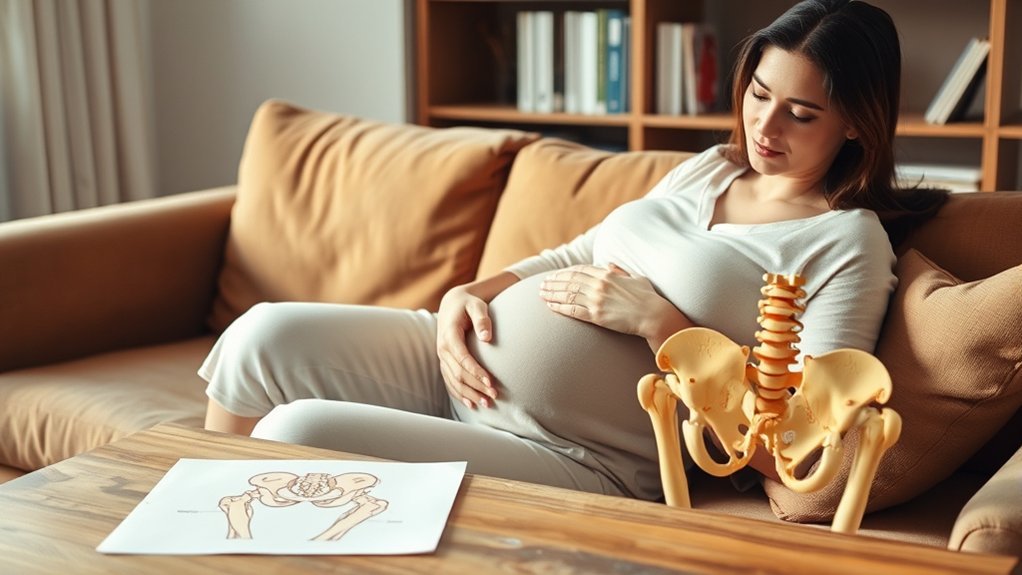Understanding round ligament pain is essential, managing your expectations is vital, and recognizing the myths surrounding it can ease your concerns. Many women experience this discomfort during pregnancy, yet misconceptions often cloud the issue. Is it a sign of something serious? Does it only happen in the later stages? These questions are common, and clarifying them can help you navigate this aspect of your pregnancy more confidently. Let’s explore the facts behind this prevalent phenomenon.
Understanding Round Ligament Pain

Many expectant mothers experience round ligament pain as their bodies adapt to pregnancy. This discomfort arises from the stretching of the round ligaments, which support the uterus.
As your uterus expands, these ligaments undergo tension, leading to sharp or aching sensations, usually felt on one side of the lower abdomen. Round ligament pain typically occurs during activities like sudden movements, coughing, or standing up quickly.
As your uterus grows, the round ligaments stretch, causing sharp or aching sensations, often felt on one side of the lower abdomen.
While it can be alarming, this pain is generally considered a normal part of pregnancy. Understanding the physiological changes your body undergoes can help you differentiate between round ligament pain and more serious complications.
Staying active and practicing gentle stretches may alleviate some discomfort associated with this common pregnancy symptom.
Common Symptoms of Round Ligament Pain

While experiencing round ligament pain, you may notice several symptoms that can help you identify this common pregnancy discomfort.
Understanding these symptoms can assist you in managing your condition effectively. Here are three common symptoms:
- Sharp, Stabbing Pain: You might feel a sudden, sharp pain on one or both sides of your lower abdomen, often triggered by movement.
- Dull, Aching Sensation: Sometimes, you may have a persistent, dull ache in the same areas, especially after prolonged standing or physical activity.
- Pain with Movement: You could experience increased discomfort when changing positions, such as standing up quickly or rolling over in bed.
Recognizing these symptoms can help you differentiate round ligament pain from other potential issues during pregnancy.
Myth: Round Ligament Pain Indicates a Serious Problem

Is round ligament pain a cause for concern? Many expectant mothers worry that this discomfort signals a serious issue, but that’s a myth. Round ligament pain is typically a normal part of pregnancy, resulting from the stretching of ligaments as your uterus expands.
| Myth | Fact |
|---|---|
| Round ligament pain indicates a serious problem. | It’s a common, benign symptom of pregnancy. |
| It occurs only in late pregnancy. | It can happen anytime as your body adapts. |
| It requires immediate medical attention. | Most cases resolve with rest and proper care. |
Understanding this distinction helps alleviate unnecessary stress. Always consult your healthcare provider if you have concerns, but in most cases, round ligament pain is just a normal part of your pregnancy journey.
Fact: Round Ligament Pain Is a Normal Part of Pregnancy
Round ligament pain is a common symptom during pregnancy, often felt as a sharp or aching discomfort in the lower abdomen.
This discomfort arises as your body adjusts to the growing uterus, stretching the ligaments that support it.
Understanding that this pain is normal can help alleviate concerns about your pregnancy experience.
Common Symptoms Experienced
During pregnancy, many women experience round ligament pain, which often manifests as sharp or dull aches in the lower abdomen or groin area. This discomfort typically occurs as your body adjusts to the growing uterus.
Common symptoms include:
- Localized pain: You might feel a sudden, intense pain on one side, often when changing positions or during physical activity.
- Radiating sensations: The pain may spread to your hips or thighs, creating a feeling of tightness.
- Intermittent episodes: You may notice that the pain comes and goes, often triggered by movements like coughing, sneezing, or standing up quickly.
Recognizing these symptoms can help you differentiate round ligament pain from other potential issues.
Always consult your healthcare provider if you’re concerned.
Causes of Discomfort
As your body undergoes significant changes throughout pregnancy, experiencing round ligament pain is a normal response to the growing uterus.
The round ligaments, which support the uterus, stretch and thicken to accommodate its expansion. This stretching can cause sharp, brief discomfort, often felt on one side of your abdomen or groin.
Factors such as sudden movements, coughing, or standing up quickly can exacerbate the pain. Hormonal changes also contribute, as increased levels of relaxin soften ligaments and joints.
While round ligament pain is usually harmless, it’s important to distinguish it from other abdominal pain. If discomfort becomes severe or persists, consulting your healthcare provider is essential for proper evaluation and reassurance.
Understanding these causes can help normalize your experience during pregnancy.
Myth: Round Ligament Pain Only Occurs in the Second Trimester
It’s a common misconception that round ligament pain only occurs during the second trimester of pregnancy.
In reality, many women experience discomfort in early pregnancy due to hormonal changes that affect the ligaments.
Understanding this can help you better manage your symptoms as your body adjusts to the demands of pregnancy.
Early Pregnancy Discomfort
Although many people believe that round ligament pain is exclusive to the second trimester, it can actually begin much earlier in pregnancy. You might experience this discomfort as your body undergoes significant changes to accommodate the growing uterus.
Here are three key points to reflect on:
- Early Stretching: As soon as you conceive, your body starts preparing, and the round ligaments may begin to stretch, leading to discomfort.
- Hormonal Influence: Increased hormone levels, like relaxin, contribute to changes in ligament elasticity, which can trigger pain.
- Activity Levels: Everyday movements, such as bending or sudden changes in position, can exacerbate this discomfort even in the first trimester.
Recognizing these factors can help you better understand and manage early pregnancy discomfort.
Hormonal Changes Impact
While many assume that round ligament pain is confined to the second trimester, hormonal changes throughout pregnancy can initiate discomfort much earlier.
As your body prepares for the growing uterus, hormones like relaxin and progesterone increase, causing ligaments to stretch and soften. This can lead to discomfort starting in the first trimester, even when you may not yet notice significant physical changes.
You might experience sharp, sudden pains during movements or changes in posture.
It’s vital to distinguish this pain from other complications, such as ectopic pregnancy or miscarriage. If you’re concerned about any discomfort, consulting your healthcare provider is essential for proper evaluation and reassurance.
Understanding these hormonal influences can help you better navigate your pregnancy experience.
Fact: Round Ligament Pain Can Occur at Any Stage of Pregnancy
Round ligament pain can arise at any stage of pregnancy, often surprising expectant mothers with its sudden onset. This discomfort results from the stretching of the ligaments that support your growing uterus.
Here are three key points to reflect on:
- First Trimester: You might feel sharp pains as your body begins to adapt to hormonal changes and increased blood flow.
- Second Trimester: As your baby grows, you may notice more frequent sensations, especially with sudden movements or changes in posture.
- Third Trimester: The increased weight can lead to heightened discomfort, emphasizing the importance of understanding your body’s signals.
Recognizing round ligament pain early can help you manage it effectively, allowing for a more comfortable pregnancy experience.
Myth: Rest Is the Only Solution for Round Ligament Pain
Many expectant mothers mistakenly believe that rest is the only effective remedy for round ligament pain. While it’s true that taking breaks can help alleviate discomfort, solely relying on rest may not address the underlying issue.
Round ligament pain often results from the stretching and pressure on ligaments as your uterus expands. Engaging in gentle movements and incorporating proper body mechanics can actually support your body during this time.
Evidence suggests that light activities, such as walking or prenatal yoga, may enhance blood flow and reduce stiffness. Additionally, maintaining muscle strength can provide better support for your growing belly.
It’s crucial to strike a balance between rest and movement to effectively manage round ligament pain during pregnancy.
Fact: Movement and Gentle Exercise Can Help Alleviate Discomfort
Engaging in movement and gentle exercise can greatly alleviate discomfort associated with round ligament pain during pregnancy.
Research indicates that staying active can promote blood flow and strengthen the muscles around the pelvis, which may reduce tension on the ligaments.
Here are three effective forms of gentle exercise:
- Walking: A low-impact activity that keeps you moving without straining your body.
- Prenatal Yoga: Focuses on stretching and strengthening the pelvic area, improving flexibility and relaxation.
- Pelvic Tilts: These can help relieve pressure on the round ligaments by engaging your core muscles.
Incorporating these activities into your routine can greatly improve your comfort levels, allowing you to navigate your pregnancy with greater ease.
Always consult your healthcare provider before starting any exercise program.
Tips for Managing Round Ligament Pain
To effectively manage round ligament pain, incorporating gentle stretching exercises can greatly help reduce discomfort.
Additionally, applying a warm compress to the affected area may provide relief by promoting blood flow and easing tension.
Together, these strategies can enhance your overall comfort during this stage of pregnancy.
Gentle Stretching Exercises
While round ligament pain can be uncomfortable, incorporating gentle stretching exercises into your routine can help alleviate discomfort and improve flexibility.
Here are three effective stretches you might try:
- Seated Side Stretch: Sit comfortably, reach one arm overhead, and lean to the opposite side to stretch your side and lower back.
- Cat-Cow Stretch: On all fours, alternate between arching and rounding your back. This movement helps relieve tension in the pelvic area.
- Hip Flexor Stretch: Stand, take a step back with one foot, and bend your front knee while keeping the back leg straight. This targets the hip area where round ligament pain often originates.
These gentle stretches can promote relaxation and improve your overall comfort during pregnancy.
Warm Compress Application
Applying a warm compress can be an effective way to manage round ligament pain, as heat helps relax muscles and improve blood circulation. When using a warm compress, follow these guidelines for ideal results:
| Step | Description |
|---|---|
| 1. Preparation | Heat a clean, damp towel in the microwave for 30 seconds. |
| 2. Temperature | Verify it’s warm, not hot, to avoid burns. |
| 3. Application | Place the compress on the painful area for 15-20 minutes. |
| 4. Frequency | Repeat every 2-3 hours as needed. |
| 5. Monitoring | Assess comfort; discontinue if irritation occurs. |
Incorporating this method into your routine can greatly alleviate discomfort associated with round ligament pain.
When to Consult a Healthcare Professional
Wondering when it’s time to consult a healthcare professional about round ligament pain?
It’s important to recognize the signs that indicate a need for medical attention. Here are three key situations to contemplate:
- Severe Pain: If the pain is intense and disrupts your daily activities, it may indicate a more serious issue.
- Accompanied Symptoms: If you experience symptoms like fever, nausea, or abnormal bleeding alongside the pain, seek help immediately.
- Persistent Discomfort: Should the pain persist beyond your third trimester or worsen over time, it’s essential to consult a healthcare provider.
Addressing these signs early can help rule out complications and guarantee a healthy pregnancy.
Recognizing and addressing warning signs early can ensure a smoother pregnancy journey and peace of mind.
Your well-being and peace of mind are paramount.
Frequently Asked Questions
Can Round Ligament Pain Affect My Baby’s Health?
No, round ligament pain doesn’t affect your baby’s health. It’s a common discomfort during pregnancy caused by stretching ligaments. While painful, it’s typically harmless and doesn’t pose any risk to your baby’s well-being.
Is Round Ligament Pain Different From Abdominal Pain?
Yes, round ligament pain differs from abdominal pain. Round ligament pain is sharp and localized, often occurring with movement, while abdominal pain can be more generalized and may signify other conditions needing medical attention.
How Long Does Round Ligament Pain Typically Last?
Round ligament pain usually lasts just a few seconds to a couple of minutes, like a fleeting shadow. You might experience it more frequently in the second trimester as your body adjusts to pregnancy changes.
Are There Any Specific Exercises to Avoid?
You should avoid high-impact exercises, deep squats, and positions that strain your abdomen. Gentle stretching and low-impact activities like walking or swimming can be beneficial, but always listen to your body and consult your healthcare provider.
Can Round Ligament Pain Worsen With Activity?
Like a tightening rubber band, round ligament pain can indeed worsen with activity. You may experience discomfort during movement, especially with sudden motions or prolonged standing. It’s essential to listen to your body and modify activities accordingly.
Conclusion
In charting the journey of pregnancy, understanding round ligament pain is like having a reliable compass. It’s essential to recognize that while this discomfort is a common part of your body’s adjustments, it doesn’t signal a serious issue. Embrace gentle movement and relaxation techniques to ease the pain, and remember, it’s always wise to consult a healthcare professional if your discomfort intensifies. By staying informed, you can confidently steer through this phase of your pregnancy.
